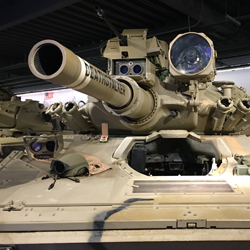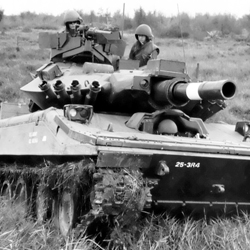The M551 “Sheridan” AR/AAV (Armored Reconnaissance/Airborne Assault Vehicle) was a light tank developed by the United States and named after General Philip Sheridan, of American Civil War fame. It was designed to be landed by parachute and to able to cross rivers. It was armed with the technically advanced but troublesome M81/M81 Modified/M81E1 152mm gun/launcher, which fired both conventional ammunition and the MGM-51 Shillelagh guided anti-tank missile.
The M551 Sheridan entered service with the United States Army in 1967. At the urging of General Creighton Abrams, the U.S. Commander of Military Forces in South Vietnam at the time, the M551 was rushed into combat service in Vietnam in January 1969. In April and August 1969, M551s were deployed to units in Europe and South Korea, respectively. Now retired from service, it saw extensive combat in the Vietnam War, and limited service in Operation Just Cause in Panama, and the Persian Gulf War in Kuwait.
The Sheridan’s most unusual feature was its large M81 152-millimeter gun/missile system. Capable of firing enormous caseless shells more devastating to infantry than the 90- or 105-millimeter shells fired by Patton tanks at the time. Against armored threats at medium or long range, the gun could instead launch the newly developed MGM-151 Shillelagh antitank missile at targets up to two or three kilometers distant. It seemed like a brilliant solution to cramming heavy firepower into a lightweight vehicle. Each Sheridan carried nine Shillelaghs and twenty shells as standard, as well as .50 caliber and 7.62-millimeter machine guns mounted on the turret and hull.
The Sheridan first served with the tank companies of Third Squadron of the Fourth Cavalry Regiment and the Eleventh “Black Horse” Armored Cavalry Regiment (ACR), replacing heavier and slower M48 Patton tanks. The Sheridans unconventional armament created some quirks in operation. The Sheridan’s light frame often leaped upwards into the air with each shot from its heavy main gun, potentially causing chest injuries to the commander if he was peering over the hatch, and also often scrambling the missile system’s electronics. This, combined with a ponderous partially automated loading system, reduced the gun’s rate of fire to around two rounds per minute. The Sheridan’s greatest shortcoming in the field lay in survivability. The M551’s armor was not intended to repel anything heavier than a heavy machine gun round, so the tanks were highly vulnerable to the land mines and rocket-propelled grenades. Adding to the danger, the Sheridan’s store of caseless 152-millimeter shells was prone to detonating catastrophically when the vehicle was penetrated.
In 1989, eight to ten Sheridans of the Third Battalion of the Seventy-Third Armored were used in the first and only parachute drop of U.S. tanks into combat by C-130 transports onto Torrijos/Tocumen Airfield during the invation of Panama. Four more M551s had already been secretly air landed into Panama before the commencement of hostilities, where they were used to breach the La Comandancia strong point with their heavy shells.
A year later, fifty-one Sheridans were scrambled into Saudi Arabia along with the rest of the Eighty-Second Airborne Division as part of Operation Desert Shield, reinforcing a “thin line in the sand” of American light infantry. It was hoped these would be sufficient to dissuade Saddam Hussein from invading Saudi Arabia with his massive armored formations. The Sheridan did eventually see action in the Gulf War, firing around a half-dozen missiles at Iraqi bunkers and destroying a single Type 59 tank. These were the only Shillelaghs ever used in combat out of more than eighty-eight thousand built. The Sheridan lasted several more years in U.S. service as part of the Eighty-Second Airborne’s rapid reaction force, but was ultimately retired in 1996.






